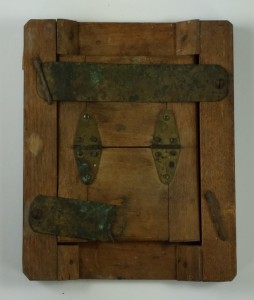Horne & Thornthwaite, Sliding Box Wet-plate Camera, (Circa 1857-1866)

The greatest loss to an antique is the loss of its history (owner, purpose, use, etc.). Yes, condition governs value on most pieces, but knowing who owned the item and their story adds tremendous personal value. In the case of this Horne & Thornthwaite camera I unfortunately do not know anything about the previous owner(s), but we can make a few speculations.
Known Camera History
First the easy to discern facts. The camera is well documented by very well know photographic pioneers. Below are a few interesting tidbits with links to more detailed sources.
- Camera: Sliding Box Wet-plate Camera
- Label: Horne & Thornthwaite, 121, 122 & 123 Newgate St. London
- Date of Manufacture: 1857 to 1866
- Owners at the time of manufacture: William Henry Thornthwaite, Fallon Horne
Horne and Thornthwaite was founded in London in the 1840’s and bought out in 1884.
The company was awarded numerous prizes including:
- Great Exhibition of London in 1851
- Great Exhibition of London in 1857
William Henry Thornthwaite PH.D., F.C.S. composed and contributed to many foundational books on photography. Reprints of his writings on the photographic arts can still be found on Amazon!
- Catalogue of Photographic Apparatus and Chemical Preparations
- A Guide to Photography
- A Popular Treatise On Photography (1863)
Google also happens to have a free ebook, The Chemical New and Journal of Physical Science, online that features an announcement with the same address and thus time period as the camera. This announcement may be related their line of microscopes.

For a more detailed history:
- Historic Camera
- Early Photography
- Google Ebook – Chemical News
- Step by Step Guide To Wet Plate Photography (Cool, how to make slides!)
- Great historical perspective including photographic process
So Who Owned this Camera?
This is the exciting question. Looking at the vast amount of equipment we can draw some conclusions (right or wrong).
Camera Condition
The camera is at this point somewhere around 150 years old. It is in great shape but has been clearly used.




Professional Add-ons
I can’t believe this, but the camera has the original lens. It is not attached and the glass and lens cap are long gone, but the fact it still exists is amazing. The replacement lens seems to be of professional grade and still has the original leather and felt cap.


In addition, there are other early apparatuses that a well-to-do armature might possess, but would seem more likely to be owned by a professional. These include an early shutter (wet plate cameras did not have shutters) and an early aperture looking device.




The camera also has a myriad of glass plate (film) holders. There are many duplicate holder types which one would expect from a professional. Once again an amateur certainly could have purchased many redundant holders, but to my ignorant eyes the number and the honest use patterns indicate steady usage over a long period.





Post Mortem Surprise?
The absolute best part of this camera is one of the slide containers has an actual developed slide of a baby! The baby is in a chair set against a wood house or barn backdrop. Now the downside of research. A slide takes between 20 seconds and 5 minutes to take depending on the chemicals. For babies, it was common practice for the parent to be camouflaged in the background holding the child still as the image set. This picture does not have any indication that there is someone or something holding the child. That brings us to our second interesting fact about the 1800s. It was common practice to take pictures of the deceased especially children. Given the picture appears to be solidly in focus with no movement, this photo might fall into the post mortem category. Below are two links to well written posts on the subject. For the purposes of this post, let’s just assume that is one well behaved baby that kept still for 30 seconds.
Victorian Parents Hiding in Pictures to Keep Their Babies Still Long Enough for a Portrait
People In The 1800s Did THIS With Dead Bodies


There two other significant clues the picture can give us.
Image Background: Note carefully the planking in the background. It is vertical. There are two methods of “plank house” construction; horizontal and vertical. Vertical construction uses wide planks that run from the floor to roofline. The time period of this construction ranges from the mid 1800s to 1910. There is a lot of good material out there, but this technique was largely in use in the United States where materials of this type were plentiful. Based on my VERY limited research, this was primarily done in the North East.
Chair: The chair is oddly wide and short. It may have a cane or wicker seat or that might just be cloth beneath the dressing gown. I would be eternally grateful if someone could help pick out the features of this chair and set a location and time. How great would it be to determine this was a 19th century American made chair.
Summary
In summary, the camera is a fantastic example of the early days of photography. I believe based on the types of equipment that came with the camera and the negative of the child this equipment belonged to a professional photographer in the mid to late 19th century. Based on the negative, I would go out on a limb and say it was in use in the United States. How the camera was preserved or came to land in Austin, Texas is unfortunately lost to time.